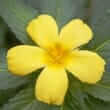Background
- Damiana includes the species Turnera diffusa and Turnera aphrodisiaca. These closely-related plants belong to the family of Turneraceae and grow wild in the subtropical regions of the Americas and Africa. Damiana is widely used in traditional medicine as an anti-cough, diuretic (increasing urine flow), and aphrodisiac agent. Recent studies in rats seem to support the folk reputation of Turnera diffusa as a sexual stimulant.
- In the Mexican culture, damiana is used for gastrointestinal disorders. Damiana extract has shown antibacterial activity against Gram-positive and Gram-negative bacteria, which may have gastrointestinal effects.
- Damiana appears on the U.S. Food and Drug Administration's (FDA) GRAS (generally recognized as safe) list and is widely used as a food flavoring. However, because damiana contains low levels of cyanide-like compounds, excessive doses may be dangerous.
References
Natural Standard developed the above evidence-based information based on a thorough systematic review of the available scientific articles. For comprehensive information about alternative and complementary therapies on the professional level, go to . Selected references are listed below.
- Alarcon-Aguilar FJ, Roman-Ramos R, Flores-Saenz JL, et al. Investigation on the hypoglycaemic effects of extracts of four Mexican medicinal plants in normal and alloxan-diabetic mice. Phytother Res 2002;16(4):383-386.
View Abstract - Alarcon-Aguilara FJ, Roman-Ramos R, Perez-Gutierrez S, et al. Study of the anti-hyperglycemic effect of plants used as antidiabetics. J Ethnopharmacol. 1998;61(2):101-110.
View Abstract - Alcaraz-Melendez L, Delgado-Rodriguez J, Real-Cosio S. Analysis of essential oils from wild and micropropagated plants of damiana (Turnera diffusa). Fitoterapia 2004;75(7-8):696-701.
View Abstract - Andersen T, Fogh J. Weight loss and delayed gastric emptying following a South American herbal preparation in overweight patients. J Hum Nutr Diet 2001;14(3):243-250.
View Abstract - Arletti R, Benelli A, Cavazzuti E, et al. Stimulating property of Turnera diffusa and Pfaffia paniculata extracts on the sexual-behavior of male rats. Psychopharmacology (Berl) 1999;143(1):15-19.
View Abstract - Dennehy CE, Tsourounis C, Miller AE. Evaluation of herbal dietary supplements marketed on the internet for recreational use. Ann Pharmacother. 2005;39(10):1634-1639.
View Abstract - Godoi AF, Vilegas W, Godoi RH, et al. Application of low-pressure gas chromatography-ion-trap mass spectrometry to the analysis of the essential oil of Turnera diffusa (Ward.) Urb. J Chromatogr.A 2-20-2004;1027(1-2):127-130.
View Abstract - Hernandez T, Canales M, Avila JG, et al. Ethnobotany and antibacterial activity of some plants used in traditional medicine of Zapotitlan de las Salinas, Puebla (Mexico). J Ethnopharmacol. 2003;88(2-3):181-188.
View Abstract - Hnatyszyn O, Moscatelli V, Garcia J, et al. Argentinian plant extracts with relaxant effect on the smooth muscle of the corpus cavernosum of guinea pig. Phytomedicine. 2003;10(8):669-674.
View Abstract - Ito TY, Trant AS, Polan ML. A double-blind placebo-controlled study of ArginMax, a nutritional supplement for enhancement of female sexual function. J Sex Marital Ther 2001;27(5):541-549.
View Abstract - Nascimento MA, Silva AK, Franca LC, et al. Turnera ulmifolia L. (Turneraceae): preliminary study of its antioxidant activity. Bioresour.Technol. 2006;97(12):1387-1391.
View Abstract - Piacente S, Camargo EE, Zampelli A, et al. Flavonoids and arbutin from Turnera diffusa. Z Naturforsch.[C.] 2002;57(11-12):983-985.
View Abstract - Polan ML, Hochberg RB, Trant AS, et al. Estrogen bioassay of ginseng extract and ArginMax, a nutritional supplement for the enhancement of female sexual function. J Womens Health (Larchmt.) 2004;13(4):427-430.
View Abstract - Zava DT, Dollbaum CM, Blen M. Estrogen and progestin bioactivity of foods, herbs, and spices. Proc.Soc.Exp Biol Med 1998;217(3):369-378.
View Abstract







